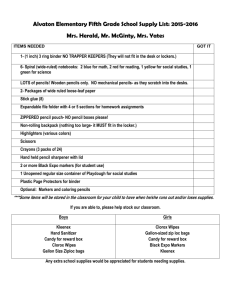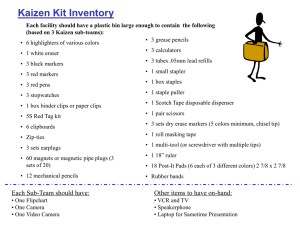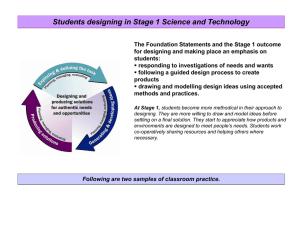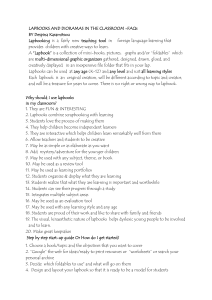TEACHING MAPPING AND ORIENTEERING SKILLS
advertisement
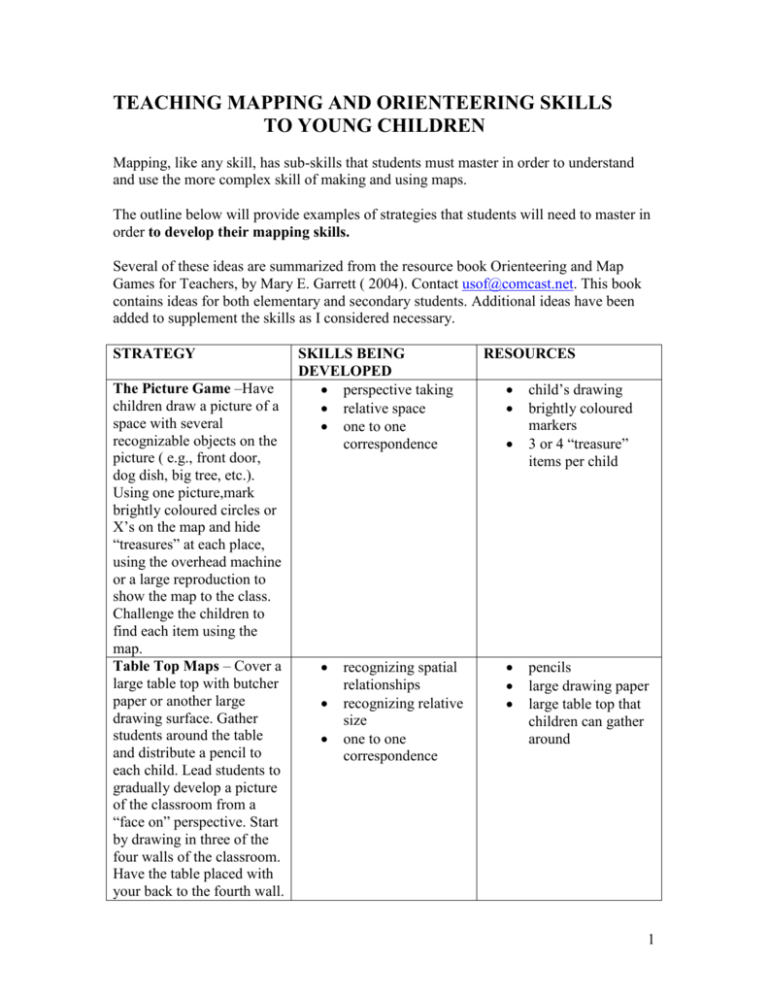
TEACHING MAPPING AND ORIENTEERING SKILLS TO YOUNG CHILDREN Mapping, like any skill, has sub-skills that students must master in order to understand and use the more complex skill of making and using maps. The outline below will provide examples of strategies that students will need to master in order to develop their mapping skills. Several of these ideas are summarized from the resource book Orienteering and Map Games for Teachers, by Mary E. Garrett ( 2004). Contact usof@comcast.net. This book contains ideas for both elementary and secondary students. Additional ideas have been added to supplement the skills as I considered necessary. STRATEGY The Picture Game –Have children draw a picture of a space with several recognizable objects on the picture ( e.g., front door, dog dish, big tree, etc.). Using one picture,mark brightly coloured circles or X’s on the map and hide “treasures” at each place, using the overhead machine or a large reproduction to show the map to the class. Challenge the children to find each item using the map. Table Top Maps – Cover a large table top with butcher paper or another large drawing surface. Gather students around the table and distribute a pencil to each child. Lead students to gradually develop a picture of the classroom from a “face on” perspective. Start by drawing in three of the four walls of the classroom. Have the table placed with your back to the fourth wall. SKILLS BEING DEVELOPED perspective taking relative space one to one correspondence recognizing spatial relationships recognizing relative size one to one correspondence RESOURCES child’s drawing brightly coloured markers 3 or 4 “treasure” items per child pencils large drawing paper large table top that children can gather around 1 Model the placement of some items in the room. Gradually release responsibility to the children to have them add other objects. As you model, discuss why you are drawing some objects larger than others to show their actual different sizes. Post the finished classroom map in the room in preparation for the next mapping lesson. On The Ceiling – Use the classroom map from the previous activity. Ask students if there are things in the classroom they couldn’t show on this map ( e.g., the fourth wall, the things behind the desk, etc.). Ask where would the children have to be in order to see everything in the classroom ( e.g., on the ceiling). Introduce students to names you will give to each of the four walls and show large cards displaying these as the four directions ( e.g., N NORTH, S SOUTH, E EAST, W WEST). Place these on the appropriate walls in the classroom so that they can be seen readily. Place another large sheet of drawing paper on the large table top and gather children around the table. Mark the four sides of the drawing paper to correspond to the direction signs placed around the classroom. Repeatedly point out these directions to aerial perspectives one to one correspondence directions (cardinal) using symbols relative size table top large drawing paper several pencils chair or other object that is easily carried 2 students as you continue your demonstration. Ask students to focus on one object in the room ( e.g., the teacher’s chair) and think of what it might look like if you were looking at it from the ceiling. Ask students to lay down on the floor and carry a chair around to show them this perspective ( e.g., holding the chair carefully above each child’s head). Then, have the children discuss and decide upon a symbol they could use to represent the chair on a new map, as seen from the ceiling ( e.g., a square with a small bracket behind it). Model the position of this symbol for the children on the large table top map. Gradually add other features of the room to this map, using symbols that children suggest. Post the finished map in the classroom. Taking A Trip – On an overhead sheet, show the aerial map of the classroom that the children made last class. Have each child take a turn to show on this map where they are at the outset of the lesson ( e.g., at their desk, on the carpet ). Have a moveable, transparent, coloured item that is small enough to represent a child on the overhead machine. Place the item where one child is sitting. Then, as children watch, move the object to another spot and aerial perspective one to one correspondence relative size relocation use of symbols relative location overhead machine overhead map of aerial view of the classroom small transparent, coloured object to represent a child(ren) on the overhead map 3 have the child move to the new spot as identified by the new location of the object on the overhead machine. Repeat this so that every child has a turn to move to a new spot. As this progresses, have children check and support each other with directions so that each child is successful getting to the new location. Visit a Friend – Have each child sit at their desk. Using the overhead machine to show the aerial map of the classroom that was created earlier, place a dot where each child is sitting. Have each child take turns to move to another seat to visit with a friend. As each child moves, show their new location on the overhead map by moving their dot from one place to another. Gradually allow students to take responsibility for moving the dots as they start to understand the idea. ( Variation: Have a small letter that represents the first letter of each child’s first name instead of the dots.) String Along – Using the classroom tabletop map, displayed on the blackboard for easy viewing, show the starting location of one student by using a symbol or blackboard magnet to represent the student. Then, attach one end of a long, colourful piece of string to the map at the child’s one to one correspondence relocation one to one correspondence directionality overhead machine aerial map of the classroom on an overhead sheet dots for each child ( or letter symbol) aerial map of the classroom string ( coloured to be seen easily against the map) 4 starting point. Now, attach the string to various other spots in the classroom to show where the student should move. As the student achieves success with the first relocation, ask students to help by giving directions for the student to find the third, fourth, fifth, etc., spots they are to move to in the classroom ( e.g., turn left, go around this desk, etc.). Secure the string to the map at each new spot before the student begins to move so that all students can see it clearly. Encourage students to use the terms North, South, East, and West as they give directions to classmates. As time allows, give each student an opportunity to be the student who moves. Crayon Game – Locate the aerial map of the classroom on the tabletop and have children gather around the table. Place several crayons or other objects around the classroom. Have children take turns going to get each object and return to the table top map and add a symbol ( e.g., X) on the aerial map where they found the object. Make Your Own Map – Have children draw their own aerial map of the classroom. Learning Your Letters Game -Place each of the one to one correspondence directionality symbolism one to one correspondence relative size direction (N, S, E, W) symbolism symbolism one to one paper pencils wall cards showing directions ( N, S, E, W) children’s aerial maps of the aerial tabletop map crayons of different colours ( or other objects) a coloured marker or plastic symbols ( e.g., game pieces) to show locations on the aerial map 5 letters of the alphabet around the classroom in various locations. Have children move around the room and use their own map (from previous lesson) to show where they have moved to find each of the letters, in order, to spell their own name. Mark each spot with the letter on their map. Emphasize that each child is to go to each letter of their name in order and ask other students questions to find out where their next letter is before moving toward it. As they find each letter, they should pause and mark their route from their last location to their current location on their map by printing the letter at the appropriate spot. Storybook Maps – Have children listen to stories with strong location elements in a Read Aloud setting. Following the reading, have students assist with drawing an aerial map of the story location. As students develop confidence with this skill, have them work with increasing independence to complete their own maps. Gradually introduce standardized symbols for items represented in maps ( e.g., for streams, churches, fields, buildings, etc). Post standardized symbols around the classroom as per word wall use. What’s Wrong With This correspondence reading a map recording location changes on a map relative location aerial perspective symbolism one to one correspondence standardized symbols one to one classroom plastic alphabet letter set pencils Read Aloud books large paper for development of common map smaller paper for development of individual maps wall cards to display standardized map symbols blank overhead 6 Map? – Display a map of the school yard on an overhead machine, using moveable acetate or plastic coloured symbols for the features of the yard ( e.g., soccer posts, basketball nets, grass, asphalt, etc.). Display these items in the wrong places on the map. Through questioning, starting with “What’s wrong with this map?” ask students to help place the items in the proper spot on the map. This can later be set up as a temporary center for students to review the concepts. Mapping Treasure Island – Display and review standardized symbols for maps ( e.g., fields, streams, trees, etc.).Post an anchor chart for these symbols. Provide each student with a blank island map showing a border area ( surrounding water) and the symbols N,S,E,W. Orally provide students with directions to gradually add features to the map. EXAMPLES : Draw in a long cliff runs along the south side of the island a trail starts in the northwest corner of the island, goes south, and then runs east along the top of the cliffs; the trail then continues north again to the inlet where ships are correspondence symbolism relative size relative location following directions using standard symbols using standard colours standardized spacing sheet coloured acetate or plastic pieces in shapes to represent an aerial view of the items in the school yard small box to store acetate/ plastic pieces if a center is being set up photocopied sheet of a blank “island” for each student pencils wall cards showing directions blackboard outline of the steps in developing the map ( evolves as directions are given) crayons or pencil crayons 7 moored a cave sits in the middle of the island a stream starts in the cave and flows to the inlet there is a marsh at the west side of the inlet where the stream joins it there are many boulders near the cave in the center of the island. Then give an instruction to get to the spot on the map where X marks the treasure. This activity can later be done ,with the children using graph paper and examples for developing the map being given in spaces ( e.g., Three spaces south of the cave is a tower). Also, students can be trained to colour the finished map using standard colours ( e.g., blue for water). Orienting Your Map – Teach students to orient their maps by modeling how you hold the classroom table top map so that your N point is facing the N point marked by posters on the classroom wall and/or the outdoor pylon or chair (see below) markers. ( e.g., “Look at my map. I turned it so that the N on my map is facing the N on the wall orienting maps to directions classroom or school yard signs showing four directions (N, S ,E, W) tape individual pages for students’ maps pencils 8 marker ( or chair or pylon). Please do the same with your map”). Teach children to turn their maps each time they change direction so that they are always in line with what they are facing. Outdoor Map Games- To teach children how to orient a map they are drawing, place four markers ( use chairs or pylons) in appropriate spots on the school yard. Mark each one with the direction N,S,E, or W. Have students face each marker holding their paper in front of them to match its position relative to where they are standing. Have each student mark their paper with N,S, E, or W to correspond to the markers. Lead students, using a question/ answer format, to mark the location of all of the school yard features on the map, using appropriate size and symbols. String Orienteering- Lay out a course of hanging symbols in various places in the playground. Pictures can be drawn on paper or from more durable materials such as magic marker on brightly coloured plastic bottles. Lay out string or footprint shapes to lead to the hanging symbols in the order you want students to visit each station. Provide each student with a personal map showing the same number and location of the markers and string or orientation symbols one to one correspondence relative size map reading one to one correspondence symbol recognition organization orientation/ direction markers to mark N,S,E, and W signs for directions (e.g., N North) tape ( to attach direction signs to chairs or pylons) chairs or pylons separate sheet of paper for each student pencils or markers area of the school yard that contains several features to be mapped station markers ( e.g., flags, brightly coloured plastic bottles, pictures, etc) individual maps for each student pencils crayons or markers string to hang station markers Note: This activity could also be done in a small group so that students work as a relay team, with each member of the team responsible for one “leg” of the activity. 9 footprint lines. As the students visit each location, have them draw the symbol or picture ( flower, animal, etc) that they find on the marker at each station. Variations on this activity could have students finding orienteering punches, pattern scissors, or colourful stickers at each station. They mark their paper in the prescribed way using whatever means the teacher has explained.Alternatively, students could collect a picture they are to colour from each station as they visit it. Courses can be made longer and more complex as students become more familiar with this skill. Graph Paper Game – Provide students with a graph paper sheet. Have each student mark N,S,E, W on their sheet and orient it to face the N. Give directions to have students locate a start point ( e.g., draw a red dot at a spot five lines east and four lines south of the top left corner of your paper). Now, provide step by step directions so that students create a pattern developing from each direction you provide. Example: move one line north east ( introduce the word “diagonal”) and draw on a dot; connect this dot with directions one to one correspondence graphing counting accurately auditory attention orientation graph paper for each student set of step by step directions to be spoken by the teacher pencils coloured markers or pencils for each student direction signs 10 the last dot using a straight line. Move one line east. Draw a dot and connect it to the last dot. Start to abbreviate your directions ( e.g., one line south) as students become familiar with the pattern. You may want to sketch a picture related to a current theme you are studying and the picture that results from following these directions will gradually emerge as students place and connect each dot. Having students colour the picture at the end of the activity will allow you to check for each students’ ability to complete this skill very quickly. Battleship- Provide each student with a file folder and a piece of graph paper. Have each student orient and mark directions on their paper (N,S, E, and W) and number each line of their paper from the north-west corner (top left) ( e.g., 1,2,3 etc, across the top (N) of their paper and 1,2,3, etc. down the left (W) side of their paper. one to one correspondence coordinates direction latitude/ longitude ( can be introduced using this activity) file folder for each student graph paper for each student pencils coloured markers paper clip for each pair of students Once the numbering is completed, assign each student a partner and give each pair a paper clip. Have students sit opposite each other and set their file folders up using the paper 11 clip to connect them to create a barrier between partners. Each partner draws 10 (or more, depending on the amount of practice you want to provide) ships on their paper so that their partner cannot see what they have drawn. Students sit on opposite sides of the barrier and call out the coordinates of their missile strike and the partner answers “hit” or “miss”. As each students’ battleships are “hit” by the partners’ coordinates, the other student uses a brightly coloured marker to draw an X through the downed ship. The game is won when one partner has had all of their ships hit. Variation: A more “world friendly” variation might be to have students “switch off” a light bulb on a partner’s sheet or other environmentally friendly and non-aggressive topic. Line Orienteering – Have each student set up a page of graph paper as per the directions for the graph paper game above ( e.g., N,S,E,W marked and numbers on lines across the top of the paper and down the left side of the paper). Give students coordinates and have then print a predetermined letter at each coordinate. The letters should be chosen to ultimately spell out a word following coordinates latitude and longitude direction predetermined letters to form a word or phrase graph paper for each student pencils classroom direction signs ( on wall ahead of time) Note: Variations of this activity might have students recording several letters, randomly picked by them on the coordinates determined by the teacher 12 that relates to a current unit. Now, give step by step directions for students to move around the page in a certain order so they “pick up” one letter at a time in that order to spell out a word or words. Once students can identify the word(s), the game is complete. Start with simple words of 6-8 letters and move to longer words or phrases as students gain experience with this approach. Puzzle Map – Create a map of the classroom, school yard, neighbourhood, or country. Photocopy the map then cut each one into puzzle pieces and place each set of pieces into a separate envelope. Have students reconstruct the map(s). This would work well as a center activity after students are familiar with it. Contour Cutouts- Teach students that contour lines show elevations on a map.Add the words “contour lines” and “elevation” to the classroom word wall. Provide each student with a large quantity of cardboard and have them create a layered contour map ( i.e., one layer of cardboard for each level of elevation) to show sample elevations in a model approximating the size of the top of their desks. Have students colour the edge of and then, once some of these letters are “picked up” by following coordinate directions from the teacher, students could be challenged to make as many words as possible using these letters. map making orientation Note: Mount puzzle map pieces on cardboard and/ or laminate them for reuse. contour lines elevation drawn or photocopied maps scissors envelopes glue (optional) cardboard scissors glue coloured pencils or markers Note: Make a hallway or library display of the finished products. Students can each be asked to bring a cardboard box from home for this activity if you plan ahead. 13 each contour level so that it is easily visible on the model. Trivia Orienteering- Plan a tour to a local event or exhibit that relates to a current unit of study ( e.g., Science Center or Royal Ontario Museum or school/ local library or heritage site). Set up a map with questions at each site marked on the map and have students follow the map to collect information to report. Providing different maps for each student or group, while creating considerable planning for the teacher, presents more challenge for the students. If all students have the same map to follow, give each student a different starting point. map reading orientation individual or group maps pencils Note: It may be necessary for the teacher to make an advance visit to the site to collect information to put on the map. Dr. N. Maynes June 2007 14
